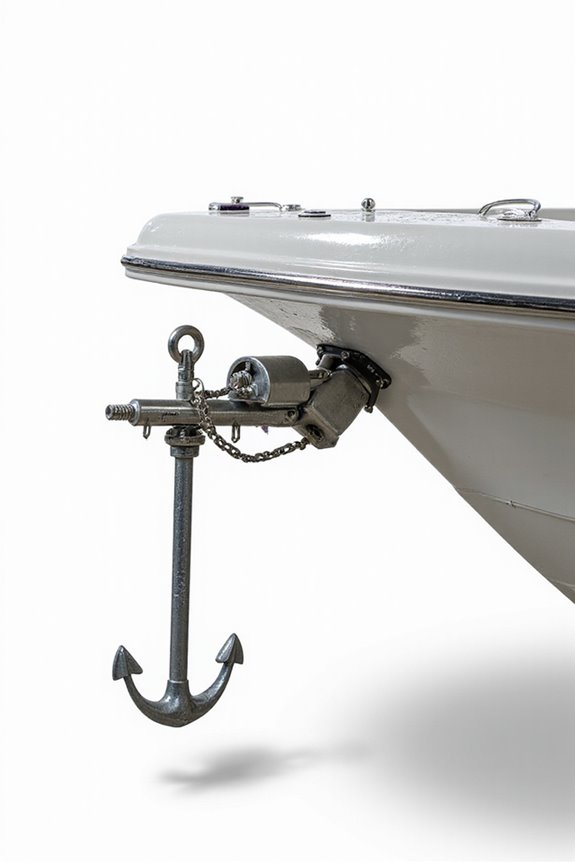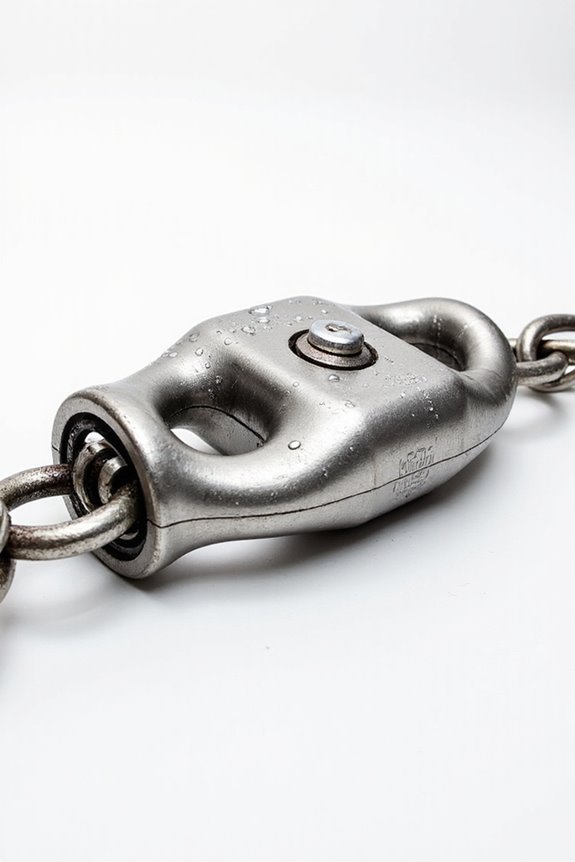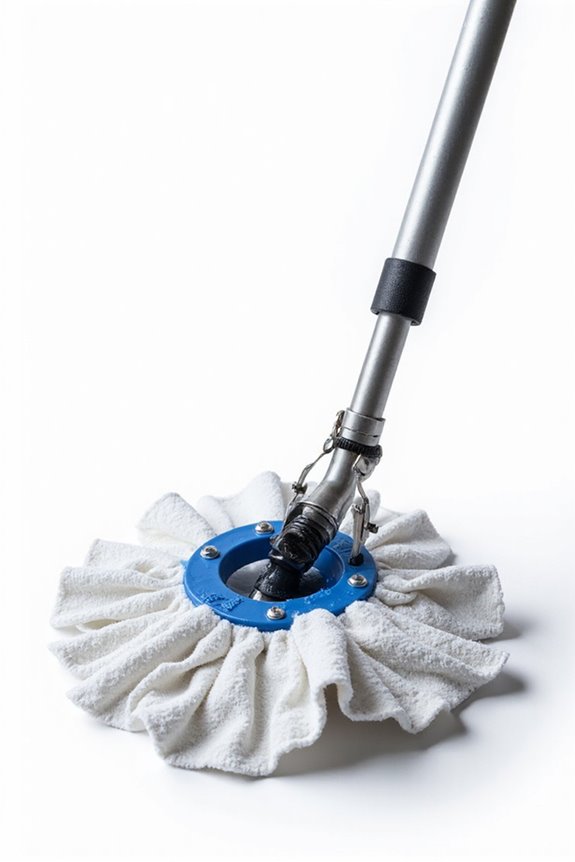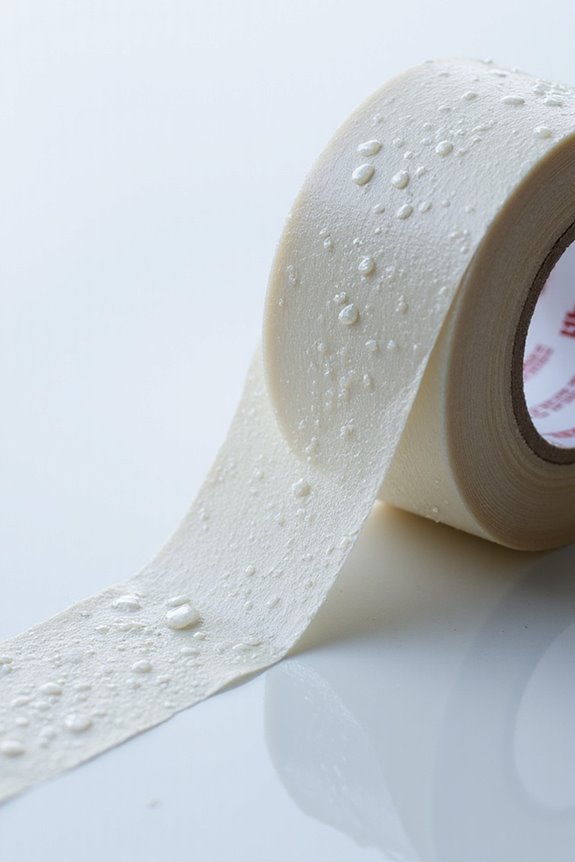Let’s face it, dealing with tangled anchors isn’t fun, so bow rollers help by guiding your anchor and chain smoothly over the bow, protecting your hull from damage. You’ll find single, double, hinged, and even specialized rollers designed for different boat shapes and anchor types. They make anchoring safer, reduce strain, and boost efficiency, especially when the sea gets rough. Picking the right one means balancing durability, boat fit, and ease of use. Keep going, and you’ll get the scoop on installation and upkeep tips too!
Key Takeaways
- Bow rollers guide anchor chains smoothly over the bow, preventing hull damage and ensuring safe anchor deployment.
- Types of bow rollers include single, double, flat, hinged, and specialized designs for different boats and anchor setups.
- Proper bow roller use reduces physical strain and enhances anchoring efficiency and precision in various weather conditions.
- Selecting a bow roller involves matching anchor type, bow shape, deck space, and ensuring marine durability and corrosion resistance.
- Regular maintenance, including cleaning, lubrication, and corrosion checks, is essential for long-lasting bow roller performance.
What Are Bow Rollers and Why Are They Important
Let’s talk about bow rollers—a small but mighty part of your boat that you might overlook until you’re wrestling with an anchor line in a splashy situation. Bow rollers guide the anchor rope or chain smoothly over the bow, preventing damage to your hull and making life safer when anchoring. They come in various bow roller designs, tailored to fit different anchors and boat setups, ensuring versatility and ease during deployment. Ever wonder why some boats have shiny stainless steel rollers while others feature sturdy plastic? That’s all about bow roller materials chosen for their durability in harsh marine conditions. Together, these features make a big difference in keeping anchoring smooth, safe, and efficient—because nobody wants to fuss with a tangled line while out on the water, right?
Different Types of Bow Rollers for Boats
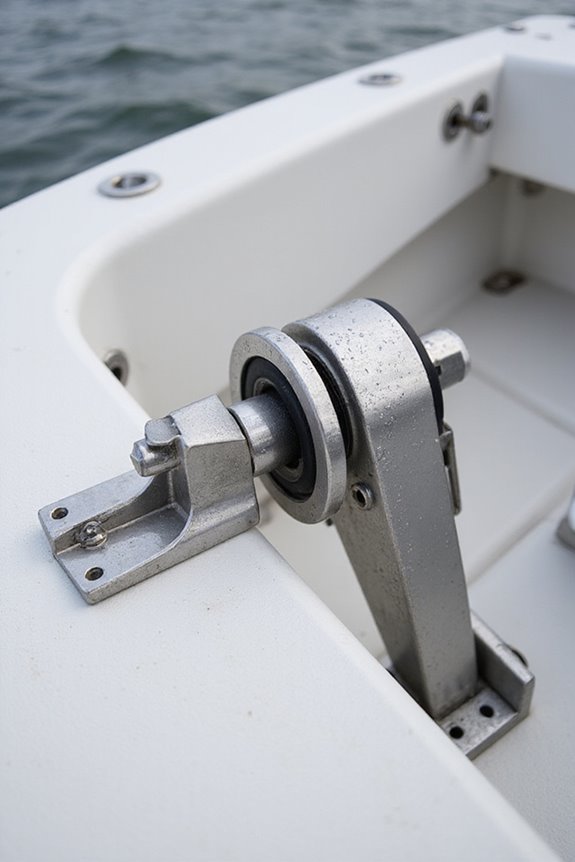
When it comes to bow rollers, there’s a surprising variety to choose from, each designed to make anchoring smoother and protect your boat’s bow in their own unique way. We’ve got Single Rollers, perfect for small boats or lightweight anchors. Double Rollers, meanwhile, offer extra stability for bigger rigs, especially on curved bows. Flat Rollers are tailored for boats with flat bows, guiding chains like a pro. Need to save deck space? Hinged Rollers fold neatly out of the way—handy, right? Pivoting Rollers and self-launching types make anchor deployment almost effortless. And if you’re after something fancy, Specialized Rollers like Nautinox Rollers with their slick two-wheel systems or a Rocker Plate design provide smooth, balanced operation. Curious which suits your boat best? Let’s explore!
How Bow Rollers Improve Safety and Efficiency
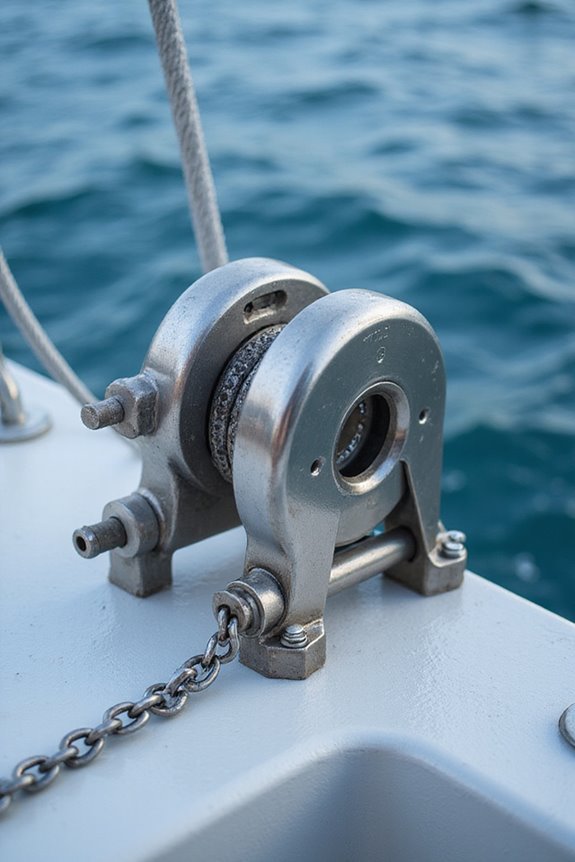
Choosing the right type of bow roller is just the beginning—understanding how these handy devices actually improve safety and efficiency onboard makes them even more valuable. Bow rollers offer real safety enhancements by reducing physical strain when we deploy or retrieve anchors, preventing accidents that could otherwise happen in slippery or choppy conditions. They protect our hulls from damage, too, keeping our boats in tip-top shape. But it’s not just about safety; bow rollers boost operational efficiency by ensuring smooth, quick anchor handling without tangles or snags. This makes changes in weather less stressful and anchoring more precise, helping us keep our boats steady and secure. Isn’t it nice when gear simply makes life easier and safer out there? That’s the magic of a good bow roller.
Factors to Consider When Choosing a Bow Roller

How do we make sure our bow roller is just right for our boat and anchor setup? First, we need to think about anchor types—whether we’re using plow, fluke, or claw anchors—and confirm the bow roller fits the anchor’s size, weight, and shank clearance. Vessel compatibility is just as vital; after all, a roller designed for a curvy bow won’t sit well on a flat one. Deck space matters too, because nobody wants a bulky contraption blocking their view or walkways. Durability and corrosion resistance? Must-haves for salty adventures. And while we all like saving a buck, choosing a bow roller just because it’s cheap might leave us stuck mid-anchor drop. So, let’s pick a roller that balances performance, fits our vessel, and keeps our anchor deployment smooth—safety first, smooth sailing second!
Steps for Proper Installation of Bow Rollers
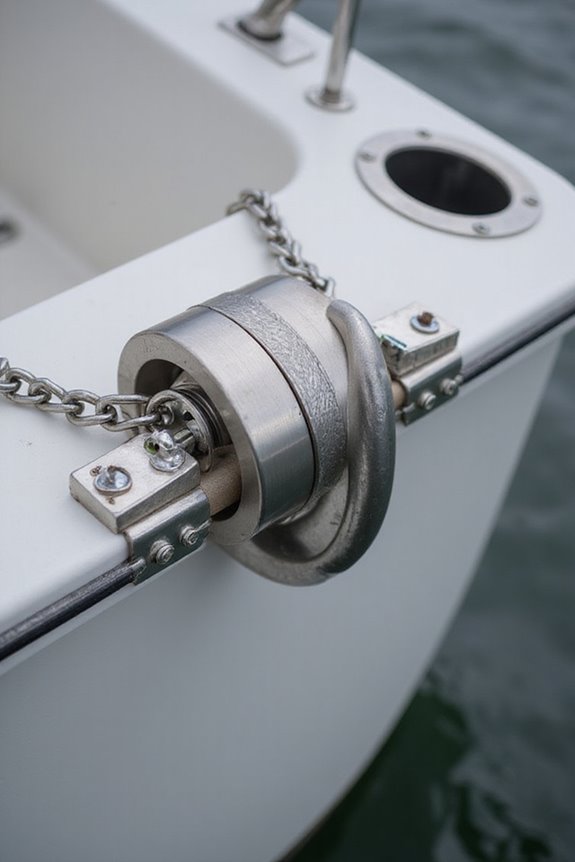
Installing a bow roller isn’t rocket science, but it does demand a bit of planning to get it right. We start by clearing the deck and marking a center line using masking tape—this step avoids common mistakes like misalignment that can cause installation challenges later. Drilling pilot holes carefully guarantees we don’t damage the deck, and applying marine sealant helps prevent annoying leaks. Ever struggled with screws stripping? Tightening hardware gradually saves us from that headache. Positioning the roller correctly before securing bolts is key—no one wants a crooked bow roller! After installation, we test anchor deployment to catch any issues early. By following these steps, we not only handle installation challenges smoothly but also join the circle of savvy sailors who know how to get the job done right.
Maintenance Tips to Prolong Bow Roller Life
Even though bow rollers might seem tough enough to handle anything our boat throws at them, they actually need regular TLC to keep working smoothly. So, how do we keep these trusty parts in top shape? First off, sticking to simple cleaning techniques is a game-changer. Rinsing with fresh water after every trip and giving them a mild detergent scrub now and then prevent salt and grime buildup—which nobody wants messing with their gear. Then, lubrication methods come into play: applying marine grease on bolts and moving parts helps avoid jams and prolongs life. Don’t forget to check for corrosion or any signs of wear during maintenance—catching issues early saves headaches later. With just a bit of care, our bow rollers will stay dependable, ready for every anchoring adventure.
Integration of Bow Rollers With Anchoring and Mooring Systems
We’ve talked about keeping bow rollers in good shape, but let’s look at how they actually team up with anchors and mooring systems. Integration techniques are key—choosing the right bow roller starts with compatibility assessments. We inspect chain size, anchor type (plow, claw, or fluke), and bow configuration to guarantee a smooth fit. Did you know some rollers even handle dual anchors for those extra tricky mooring jobs? Plus, features like chain stops and slotted rollers help control deployment and prevent mishaps. When combined with windlasses, these rollers reduce effort and keep everything aligned—no skipping chains here! Whether you’re cruising close to shore or braving offshore conditions, understanding these integration points makes the whole anchoring experience steadier, safer, and yes, a little less work for us all.
Customizing Bow Rollers for Unique Boat Requirements
While standard bow rollers work fine for many boats, it is understood that unique vessel shapes and anchoring setups call for something a bit different. That’s where custom designs come in, letting us tailor bow rollers to fit your boat’s exact dimensions and anchoring needs. Ever struggled with a roller that just can’t handle your heavy anchor? Customizing load capacity guarantees your bow roller won’t be the weak link when you’re dropping or hoisting anchor. We can also tweak materials and add features like skid plates or pivoting rollers to make deployment smooth and stress-free. So, whether your boat has an unusual bow or you’re rocking an oddball anchor, remember: one size never fits all when it comes to bow rollers. Ready for a fit that feels just right? Let’s plunge into it!
Frequently Asked Questions
Can Bow Rollers Be Used With Electric Anchor Windlasses?
Like a well-matched dance duo, electric windlasses and bow rollers perform seamlessly together when bow roller compatibility is spot-on. We’re all part of this community seeking smooth, reliable anchor deployment—let’s make sure our gear works in perfect harmony.
What Is the Average Lifespan of a Stainless Steel Bow Roller?
It is understood stainless steel durability typically gives bow rollers a 10–20 year lifespan. With regular bow roller maintenance and care, we can all extend performance and enjoy smooth anchoring experiences together on the water.
How Do Bow Rollers Affect Anchor Chain Noise?
It is understood roller material impact is huge—metal rolls often increase anchor noise. For anchor noise reduction, we prefer dense urethane rollers; they cut noise, lessen chain wear, and help us all enjoy quieter, cozier anchoring moments together.
Are Bow Rollers Suitable for Inflatable Boats?
When considering inflatable boat compatibility, it is understood that bow roller materials matter greatly. Lightweight, soft options work best to avoid damage. Together, we can choose solutions that protect our boats and make anchoring easier and safer.
Can Damaged Bow Rollers Be Repaired or Must They Be Replaced?
Remember when our car’s tire got a tiny puncture? Like that, damaged bow rollers can sometimes be fixed with repair techniques, but if the damage is severe, exploring replacement options guarantees safety and lasting peace of mind for us all.

